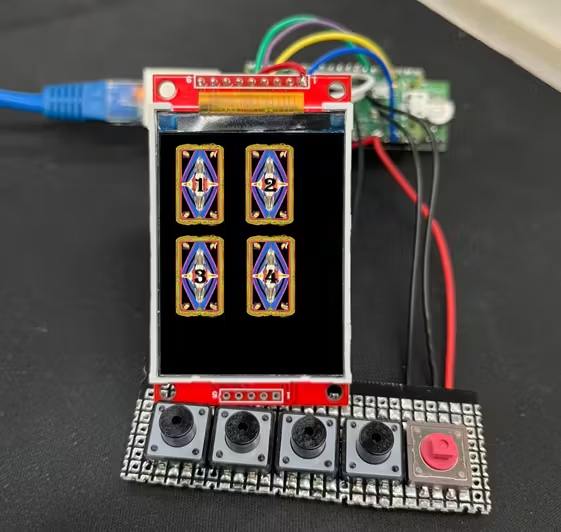Pi Pico Uses Chat GPT and Dall-E-2 to Generate Tarot Cards

This isn’t the first time we’ve seen the Raspberry Pi crossed with the world of Tarot. We previously covered a project in which a Pi generated Tarot cards based on EM noise. But today, we’re sharing one that generates cards and artwork with a little help from artificial intelligence. Maker and developer Alan used both Chat GPT and Dall-E-2 to create custom artwork for Tarot cards on demand.
The project is based around a Raspberry Pi Pico. It’s connected to a screen that shows four possible Tarot cards. Four buttons can be used to select a given card. The Pico accepts this input and processes it to choose a random Tarot card for the user; at this point, Chat GPT and Dall-E-2 come into play.



These AI systems are responsible for parsing a description of the card to Dall-E-2, which generates a unique image for the card based on the description. The image is then returned to the Pico, which displays it on the LCD screen. After the custom image is displayed, a brief description of the card appears.
To recreate this project, you’ll need a few specific components. In this case, Alan uses a Raspberry Pi Pico with a W5100S module that features Ethernet support. However, you could easily use a Pico W in its place. It uses five buttons total and connects to an SPI-based LCD screen.
Alan was kind enough to share the juicy details about this project and how the code works. You can find a full breakdown of the Pico Tarot system and how to set it up on the official Hackster page for the project. You will need access to the Chat GPT and Dall-E-2 APIs to bring everything together.
To get a closer look at this Raspberry Pi project in action, check out the video shared by Alan on YouTube and delve into the details over at Hackster. Be sure to follow Alan for more projects and any future updates to this one.
Get Tom's Hardware's best news and in-depth reviews, straight to your inbox.

Ash Hill is a contributing writer for Tom's Hardware with a wealth of experience in the hobby electronics, 3D printing and PCs. She manages the Pi projects of the month and much of our daily Raspberry Pi reporting while also finding the best coupons and deals on all tech.
-
LabRat 891 If I didn't know any better...Reply
I'd say a lot of AI devs and deployers are into precisely the "freaky 'ish" some other people think is going to be brought into our world via AI.
I'm not into that crap, but I'm starting to become unable to ignore it. I've seen too many things 'meme into reality' already. -
Giroro All I know is that Google worthless algorithms randomly decided a couple weeks ago that horroscopes need to be shoved down my throat on a daily basis. So now I get to see a dozen different (usually outdated, and usually from Chicago) daily postings of this fake psychic superstition exploiting garbage in both my "breaking news" feed and my YouTube home page. None of the variants of the "stop showing me this crap" buttons throughout Google's product ecosystems have ever worked... So this is frustrating.Reply
It's even happening in Bing/MSN, so it might be a real trend, which is very sad for society. -
DSzymborski I only do AI for silliness. Weirdly, my only appearance on CNN was for silly AI nonsense I made for Presidents Day weekend (I normally do media for completely unrelated things to that).Reply -
LabRat 891 Reply
Read that as NTFS, and got thrown-back to the release of Windows XP for a split-second...derekullo said:My tarot card said I was very gullible followed by a link to buy nfts. -
Darkoverlordofdata Terrible artwork, bad interpretation. Typical AI. No one can use these unless they are ignorant of the Tarot.Reply
